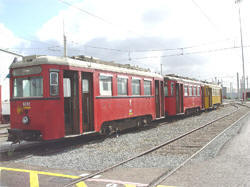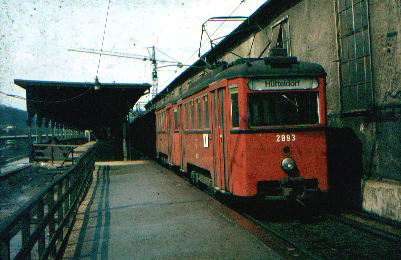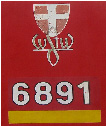Vienna Cars
History Of The Vienna N1 Class Cars—Part 1 - Article by Chuck Bencik (appeared in the July, 2007 Trolley Lines newsletter)
 |
| SDERA’s Vienna Cars as they sat on Track 8 at the San Diego Trolley yard prior to arriving at the National City Depot - as seen Oct ‘04 Trolley Lines |
Parts of the red (and yellow) N1 cars at the north end of the National City Depot have a history that goes back to the beginning of electrified fast City transit in Vienna, Austria. While the bodies were designed and built in the early 1950s, the years after World War II required frugality. Their electrical and mechanical operating equipment consists of recycled parts of the type N cars built from 1925 to 1927. Our yellow NH 6888, being the former passenger car 2882, is the oldest of the surviving N1 cars, and the second N1 delivered to Vienna in 1954.
When in 1924 Vienna's government decided to electrify the City railway, leasing its rolling stock for 10 years, it became a separate entity from the National Railway. A two-axle wooden-bodied car, designated class N, was built in the Railway Carriage Works, along with a trailer car, the n1. The inaugural run occurred on June 3, 1925. Trains of 9 cars, 3 of them motorized, ran in multiple unit-control, with air brakes, electromechanical signal boxes, signal towers to supervise crossing and switching, and automatic signaling section switching. While safer, faster and cleaner than the steam trains, the Viennese were disappointed by their looks. The Viennese called them “the red shoe boxes.” They had special modern equipment, but they were merely two-axle streetcars, instead of the hoped-for four-axle high speed cars with individual compartments. Gradually, the Viennese took to liking their punctuality, and Sunday excursion loads came to be especially large. Originally painted red and white, the N cars got so badly begrimed by their brake pad dust, that their livery was changed to all-red, from 1929 until 1983.
 |
| Vienna: former Stadtbahn MU 2893 at Hütteldorf Terminal, March 1980 Photo by Benutzer | Mäfä from wikipedia.com |
All areas of Vienna, including track systems and rolling stock of the City Railway rapid transit routes, were so badly damaged during World War II, that not until Fall of 1954 were the lines completely restored. Damaged and abandoned City Railway cars were eventually brought by US Army flatbed trucks, then driven over streetcar tracks, to the maintenance works. The firm of Simmering-Graz-Pauker (SGP) designed an unimposing steel body, easily mistaken for a maintenance service (or “helper”) car. The first of these, the N1 cars, and their n2 trailers, went into service July 12, 1954.
They were a curious mixture of the old and the new. Mechanical and electrical components of the older 1920s-period cars were reused in the construction of the main components of the N1s. There were both technological and passenger comfort improvements. The steel bodies had electro-pneumatic doors, and a fast-acting electro-pneumatic brake system, for convenience and safety. In their wooden single-compartment interior arrangement, seats were made of Durofol – a wood impregnated with resin, formed under pressure.
Other improvements meant the new cars could not operate with the old: the new
Sharfenberg couplings for one-man operation. All trains had to be  nine-car
trains. The sidewalls originally covered the trucks, or bogies, but soon new
sidewalls were installed which exposed the bogies for easier accessibility by
the brake inspection teams. N1 cars 2881 thru 2922, and trailer cars 5821 thru
5875 were delivered in 1954. The SDERA N1 cars were numbered 2882, 2950 and
2951, as passenger cars. New N1s were added until 1961, when they totaled 130,
with 200 of the n2 type trailer cars.
nine-car
trains. The sidewalls originally covered the trucks, or bogies, but soon new
sidewalls were installed which exposed the bogies for easier accessibility by
the brake inspection teams. N1 cars 2881 thru 2922, and trailer cars 5821 thru
5875 were delivered in 1954. The SDERA N1 cars were numbered 2882, 2950 and
2951, as passenger cars. New N1s were added until 1961, when they totaled 130,
with 200 of the n2 type trailer cars.
The N1 cars were experimented with, and modified. Cars 2879 and 2880, the last of the N1s, had special high speed motors. In 1965, the N1s were fitted with safety systems based on magnetic train control, and dead man control equipment. Meanwhile, some of the street trolley system was being replaced with subways, and some of the N1 cars entered service on the U-bahn, or subway transit system. In 1980, the livery of the Vienna tramways went to the red-and-white paint scheme.

